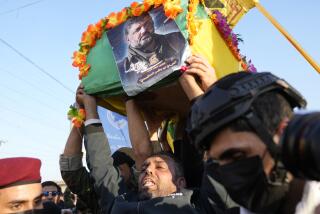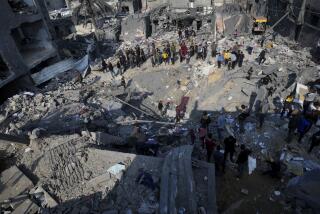In Baghdad, a Solid Offense Met the Shadow of a Defense
- Share via
WASHINGTON — The rapid seizure of Baghdad by U.S. forces owes its success to a can’t-lose formula: overwhelming superiority in firepower, training and strategy -- and an enemy so disorganized and underpowered that it never mounted a real defense.
Not even those who planned the war anticipated just how fast Iraq’s forces would collapse after the U.S. broke through the four Republican Guard divisions ringing Baghdad late last week. The war plan, officials said, had been to break through those defenses, then circle the city and patiently conduct armed raids inside.
The probes were designed to test the state of the enemy’s defenses and gather intelligence on the urban terrain. War planners had expected that the probes could take more than a week. But just three days later, U.S. troops were sleeping on the streets of central Baghdad and occupying key government buildings, presidential palaces and jails.
They did it by launching a multi-pronged attack that worked so well at least in part because Saddam Hussein’s military had little experience in coordinating its movements or activities, according to U.S. officials.
Three large task forces of the Army’s 3rd Infantry Division maneuvered their way into central Baghdad relentlessly, narrowing the space where top officials might be hiding.
U.S. ground and air commanders made tactical shifts that took advantage of the outmatched enemy forces.
By training firepower on pockets of Iraqi resisters, then rapidly pushing columns of U.S. fighters forward and in some cases quickly changing course and calling in artillery and U.S. warplanes to rain bombs on their foes, the Army and Marine troops who led the sprint into the city were able to move faster than Iraqi forces expected and overwhelm them at the very center of Hussein’s power.
“It’s like [Muhammad] Ali in the boxing ring,” a Pentagon official said, speaking on condition of anonymity. “You got the guy back on his heels, you keep after him.”
The 2nd Brigade of the 3rd Infantry Division, which set the stage for the assault by ramming its way into the center of the city Monday, stayed there, using government plazas as a base to strike out at Iraqi forces.
The 3rd Brigade maneuvered around to the north of the city and drove south. And the 1st Brigade attacked from the west, while Marine units attacked from the east. And all the while, special operations forces attacked within the city.
The U.S. troops encountered fierce fighting in the city, punching their way Tuesday through a traffic circle made treacherous by enemy fire, grenades and land mines planted in a crosswalk, and Wednesday through a firefight with Iraqi holdouts who had retreated to a university campus. But no defense mounted by the Iraqis, who seemed to be operating in small, scattered groups, came close to stopping the U.S. advance.
“We were able to engage in this ... process without necessarily getting heavily engaged at any one point,” one U.S. military official said. “We would have mean little firefights for 20 minutes, but we didn’t find occasions where the enemy tried to stop us.”
The failure of the Iraqi forces to strike back effectively was caused partly by U.S. airstrikes, which decimated Hussein’s communications lines.
“At the end of the day, the inability of Baghdad to talk to commanders in the field has been key,” the Pentagon official said. “The fact that [Hussein] has not repositioned units as we attacked forward, the implication is that he can’t communicate with his forces in the field.”
But there may be another reason Hussein’s forces did not fight together. U.S. commanders believe Hussein didn’t let them.
They say Hussein had kept the army fragmented, prohibiting his unit commanders from developing the capacity to coordinate their movements. U.S. Army Gen. Tommy Franks, the commander of allied forces in Iraq, believes Hussein feared that if commanders learned to work together, they might turn on him.
From the beginning of the war, Secretary of State Colin L. Powell said in a Los Angeles Times interview Wednesday, “there was no coherent defense. It was not contiguous, it was not coherent, it just seemed to be they were just having a series of what we call meeting engagements.... There was no front that was opposing the movement of either the British or the Americans.”
Meanwhile, U.S. and British warplanes flew close overhead, striking where forward air controllers on the ground told them to, Col. Mace Carpenter, chief of strategy for the air war, said in a phone interview from the military’s combined operations center in Saudi Arabia.
Carpenter said that long before the campaign began, Air Force war planners had mapped out Baghdad on an electronic grid, identifying every building and structure with coordinates that were then given to air and ground commanders. The detailed grid, he said, allowed air and ground troops to communicate with extraordinary precision on what to strike when, and which munition to use.
More to Read
Sign up for Essential California
The most important California stories and recommendations in your inbox every morning.
You may occasionally receive promotional content from the Los Angeles Times.













